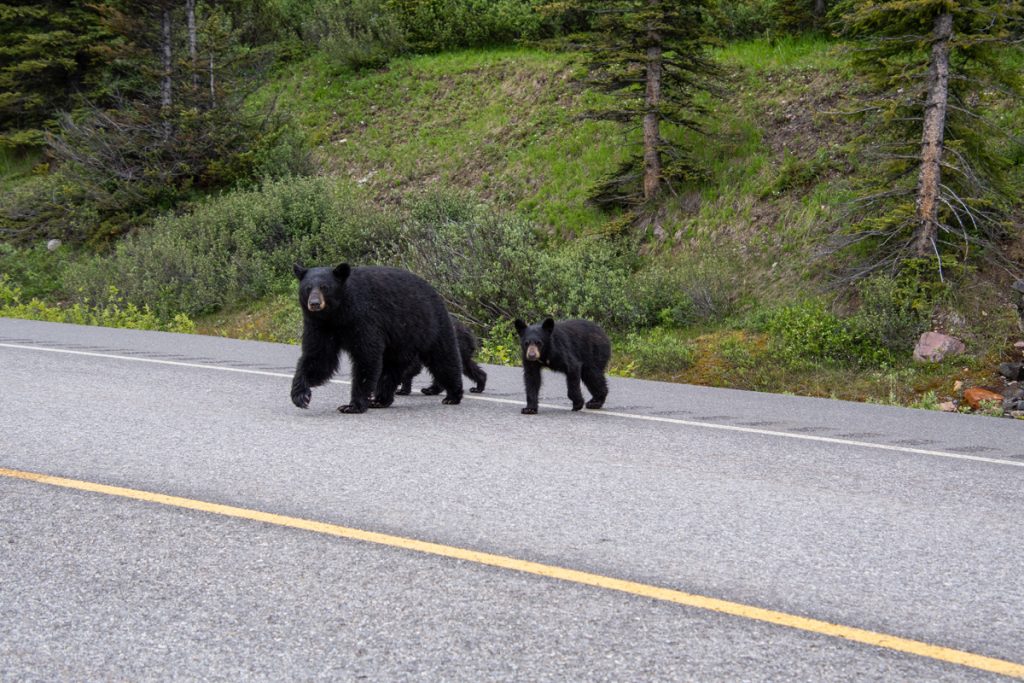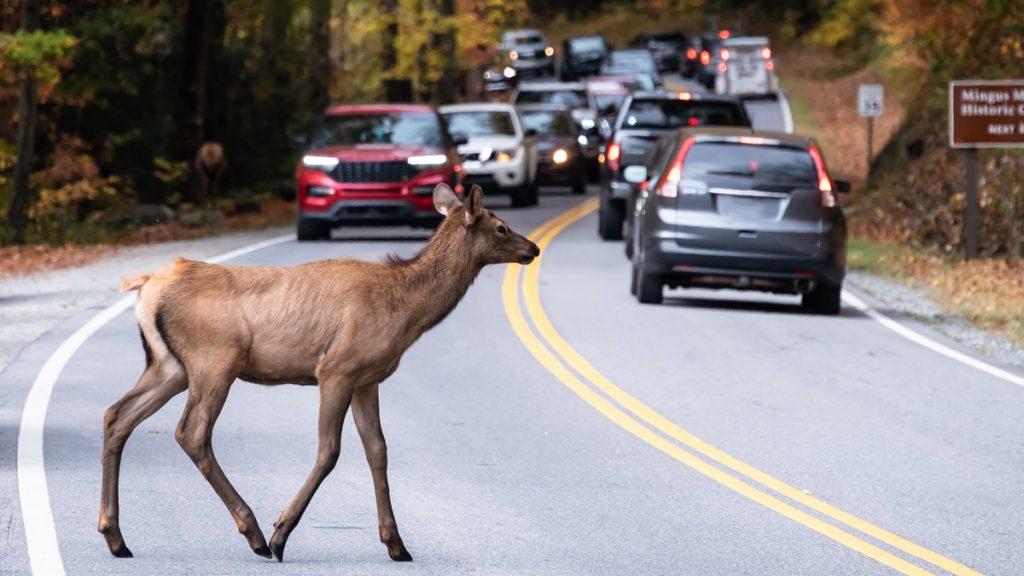Partnering for solutions to help wildlife survive
A mother black bear is approaching one of the busiest highway crossings near the Great Smoky Mountains. She looks back to make sure her cubs are close by. She’s making a life-threatening journey for food over four lanes of raging interstate traffic. It’s the only way to cross and prompts countless hold-your-breath moments for I-40 travelers. In America, more than 1 million animals die trying to cross these roadways every year. But regional organizations are putting in effort to make their journeys safer.
Safe Passage, the I-40 Pigeon River Gorge Wildlife Crossing Project near the Great Smoky Mountains, may well be a national model that is inspiring highway engineers, architects and state leaders. Many have long been involved in seeking humane alternatives to wild animals crossing intensely busy highways just to get needed variety of foods and find healthy mates outside their own families. The more traffic, the more terrifying for animals—and yes humans—who can be injured or killed in collisions that result. More than 28,000 vehicles travel on I-40 between Tennessee and North Carolina every day, according to the Tennessee Wildlife Federation. This interstate cuts through incredible wildlife habitats in the Great Smoky Mountains.
The good news is the success of wildlife crossings in the United States looks phenomenal, reducing motorist collisions with wildlife by up to 97 percent. And even as the eastern U.S. has lagged behind other parts of the nation and other countries like Canada, the Safe Passage project is bringing together many diverse agencies to create safe crossings along this corridor.
Jeff Hunter is the Southern Appalachian Director for the National Parks Conservation Association and has been the project’s tireless ambassador for years. He believes building safe crossings for bear, elk, deer and other wildlife will save lives and boost safe traffic along the 28-mile stretch of I-40 from Tennessee into North Carolina.
The project’s massive research—“so big it can’t be emailed,” says Hunter—is being hailed as a tool for many regions in the eastern U.S. looking to make it safer for wildlife to cross interstates and highways. This endeavor now has the support of numerous regional and state leaders including the governor of North Carolina.
Hunter remembers the first time he saw a dead bear on the side of the road at Sam’s Gap, which runs through the mountains of western North Carolina and upper east Tennessee. “It took my breath away.”
It Began With A Conversation
It began in fall 2017 with a conversation when Hunter managed to bring seven state and environmental organizations to the table. “I am not a biologist. I’m a naturalist, spending time looking at animals, and I have a corporate background in the telecommunications industry.” He was a data center manager in New York for a company that later became Verizon before he moved to Chattanooga to work for the National Park Service. His work with NPCA also includes the Great Smoky Mountains. In 2022, he was named Wildlife Conservationist of the Year at North Carolina Wildlife Federation’s 58th Annual Governor’s Conservation Achievement Awards Ceremony.
Getting together multiple organizations with different missions for such a gathering was daunting. The meeting revealed scarce resources, skepticism, and the fact that such wildlife crossings are not easy projects.
This heavily researched project shows clear data on wild animals and vehicle accidents from animals trying year-in and year-out to make the dangerous trek. The research report showed hundreds of bears alone were dying each year and had previously been undercounted along this 28-mile stretch of I-40.
“I can’t put a date on exactly when shovels go into the ground to create new crossings. But we now have the evidence from the years of research, and we want to see it happen,” Hunter says.

We’re All Ridge Runners
The study is one of the largest road ecology research projects ever completed in the eastern U.S.—including extensive wildlife-camera research. Crunching the data shows that it is cheaper to mitigate because of the loss of human life, animals and numerous traffic jams. The study also shows where the chaos is—primarily on a stretch of I-40 with the most conflict at bridges and exits on roadways. “That’s because the animals find these passages as the least resistant,” Hunter says. “We’re all trying to get there at the same time—whether you are a bear or a human. We’re all ridge runners, and the roadways cut in 1968 were also used by the animals.”
The one big message of the study? There is a better way—a way to forever help animals safely cross I-40 in the Pigeon River Gorge.
Today, organizations working on the Safe Passage coalition with NPCA include The Conservation Fund, Defenders of Wildlife, Great Smoky Mountains Association, North Carolina Wildlife Federation, The Wilderness Society, and Wildlands Network. The Tennessee Wildlife Federation is Safe Passage’s voice in Tennessee. “Though not an official part of the fund coalition, their staff works closely with Tennessee DOT and Tennessee Wildlife Resources Agency to advance our vision in the Volunteer State,” Hunter says. “We couldn’t be more grateful for their dedication to our shared cause.” Overall, the goal of the Safe Passage project is to build infrastructure for wildlife crossings along the 28-mile stretch of I-40 and make that area safer for animals and humans alike. This particularly scary stretch of interstate makes up 8 miles in Tennessee and 20 in North Carolina.
An important marker for the project came in 2019, when the North Carolina Department of Transportation announced that five previously planned bridge replacements would soon begin. Data identified these bridges as mortality hotspots for wildlife. Since it would be decades before they would be replaced again, Hunter saw an opportunity to provide safe passage if they could be redesigned for wildlife. Though NCDOT had no funding for wildlife provisions, their new collaborative partners urged them to try inexpensive modifications on bridge replacements at Harmon Den and over Jonathan Creek, both near the Great Smoky Mountains.
Harmon Den has two wildlife-friendly “benches” or pathways beneath the new bridge. In the replacement of the “high bridge” over Jonathan Creek, NCDOT is creating similar benches, primarily for elk. “There are additional bridges that will be replaced,” Hunter says. “We are hopeful NCDOT will include design elements that will make the roadway more permeable for wildlife.” At the time of this writing, the wildlife crossings, which include wildlife fencing as part of the Harmon Den and Jonathan Creek bridge replacements, were nearly complete. Wildlife is expected to begin using the Harmon Den bridge access more frequently as vegetation grows, encouraging animals to feel safer and more secure.
The Safe Passage project has raised approximately $130,000 to bring private dollars to the table, with a larger campaign possible as they leverage more money. Hunter is encouraged. “The general public is very supportive of the Safe Passage project, which leaves me optimistic about raising additional funds to support this important work.”

Competing For The Same Space
“One thing that surprised us from the research is that most of the wildlife-vehicle conflict is associated with structures on I-40 like bridges, interchanges, etc. The reason for this is pretty simple,” Hunter says. “Wildlife use ridges and gaps to move across the landscape on the least-cost path. In other words, rather than climbing a 45-degree slope, they often follow creeks and rivers—choosing to expend less energy.”
These places in the landscape where there is a least-cost path are also where the highway engineers located bridges and exchanges, so humans and wildlife are competing to move through the same locations.
The research also showed significant unrecognized mortality in the Pigeon River Gorge. “By counting carcasses—103 dead bears in 3 years—we identified mortality hotspots, which allow us to focus on recommendations to mitigate the problem. That research tells us we can factor 103 dead bears by 2.9. Not everything that gets hit results in a carcass that can be counted,” Hunter notes.
“If we build these in the right places—wildlife hotspots—it can pay for itself,” he says. This kind of conservation would protect what future generations will have. It is all values driven, he adds.
What’s Next? A “Big, Hairy, Audacious Project”
As Hunter looks at the future, the need for safe wildlife overpasses will get even greater. Around this stretch of I-40 are two national forests, the Appalachian Trail, and the most popular national park in the United States. The interstate is surrounded by some of oldest mountains in the world, and the number of visitors who want this stunning mountain experience continues to grow.
Hunter’s goal for the Safe Passage project is a “big, hairy, audacious” one. He wants to see wildlife overpasses in North Carolina and Tennessee large enough for elk and bear alike with strategic fencing.
Emily Jones, NPCA Southeast Regional Director in Knoxville, agrees. “This research data pinpoints the places where drivers and wildlife are most vulnerable to accident. And as the state applies for infrastructure dollars, the research will be critical in building the ‘big, hairy, audacious’ wildlife overpass,” Jones says.
The collaboration of so many is stunning. “Another great accomplishment has been the gathering of community organizations, wildlife and conservation nonprofits, legislators, breweries, and Great Smoky Mountain partners to work together toward a successful outcome,” Jones says.
Department of Transportation projects can take decades to complete. By starting now to plan for the construction or reconstruction of overpasses and underpasses that create animal friendly space, Jones hopes to see data-driven solutions implemented into ongoing transportation projects in the Southern Appalachians. And that may come sooner than anticipated. In November 2023, the North Carolina General Assembly allocated $2 million in funding for infrastructure to help reduce wildlife–vehicle collisions across the state.
Animals Need A Hand
“People come to the Smokies to see the bears, but the bears can’t build a road or right of way that is safe,” Jones says. “People can, and North Carolina can take the lead in the eastern U.S. by protecting both the animals and drivers in our gorgeous part of the world.”
Jeff Hunter imagines driving and seeing these wildlife crossings—wildly popular with the general public in other parts of the United States. “All our partners in this project—we keep coming together. This is what matters.”
